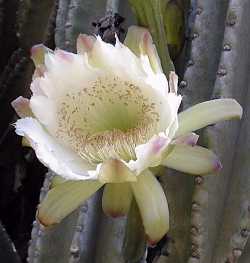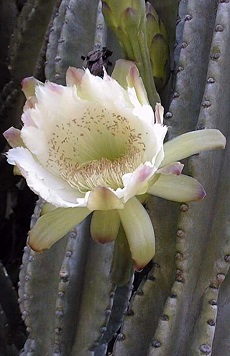Queen of the Night
Scientific Name: Cereus hildmannianus K. Schum.
Synonym: Cereus hildmannianus ssp. xanthocarpus , Cereus milesimus, Cereus neonesioticus, Cereus peruvianus, Cereus xanthocarpus, Piptanthocereus bageanus, Piptanthocereus neonesioticus, Piptanthocereus xanthocarpus
Family: Cactaceae
Sunset®: 12-13,16,17,21-24
USDA: 9-11
Frost Tolerance: Hardy to 15°F (-10°C)
Sun Exposure: Full sun
Origin: Southeastern Brazil, northern Argentina
Growth Habits: Columnar cactus branching from the base, up to 30 feet tall (9 m), clump up to 15 feet in diameter (4.5 m), stems are 5-7 inches in diameter (12-17 cm), often no spines on younger stems, spines grow progressively as the stem ages.
Watering Needs: Does best with moderate water and monthly application of fertilizer in summer
Propagation: One of the easiest cactus to propagate by cuttings

This species is popular in cultivation and often encountered in southern Californian gardens, as well as in Phoenix. The stems have 5 to 8 narrow ribs with areoles 1-inch apart. Depending on the variety, the areoles are either almost spineless (C. hildmannianus) or with 7 radial spines and a central spine, measuring around 0.4 inch long (1 cm).
Blooming Habits:
The 6-inch (15 cm), white, flowers open at night. They are followed by large, red, egg shaped fruits that split open when ripe.
Desert-Tropicals is dedicated to provide gardening advice, gardening ideas, and information about flower of all kind for landscape and collections.We try to check carefully the identification of the plants on the illustrations as well as the other information from the page, but occasionally errors do occur. if you notice anything that needs to be changed please contact us.Thanks.
© 1998-2020 Philippe Faucon, All Rights Reserved.
